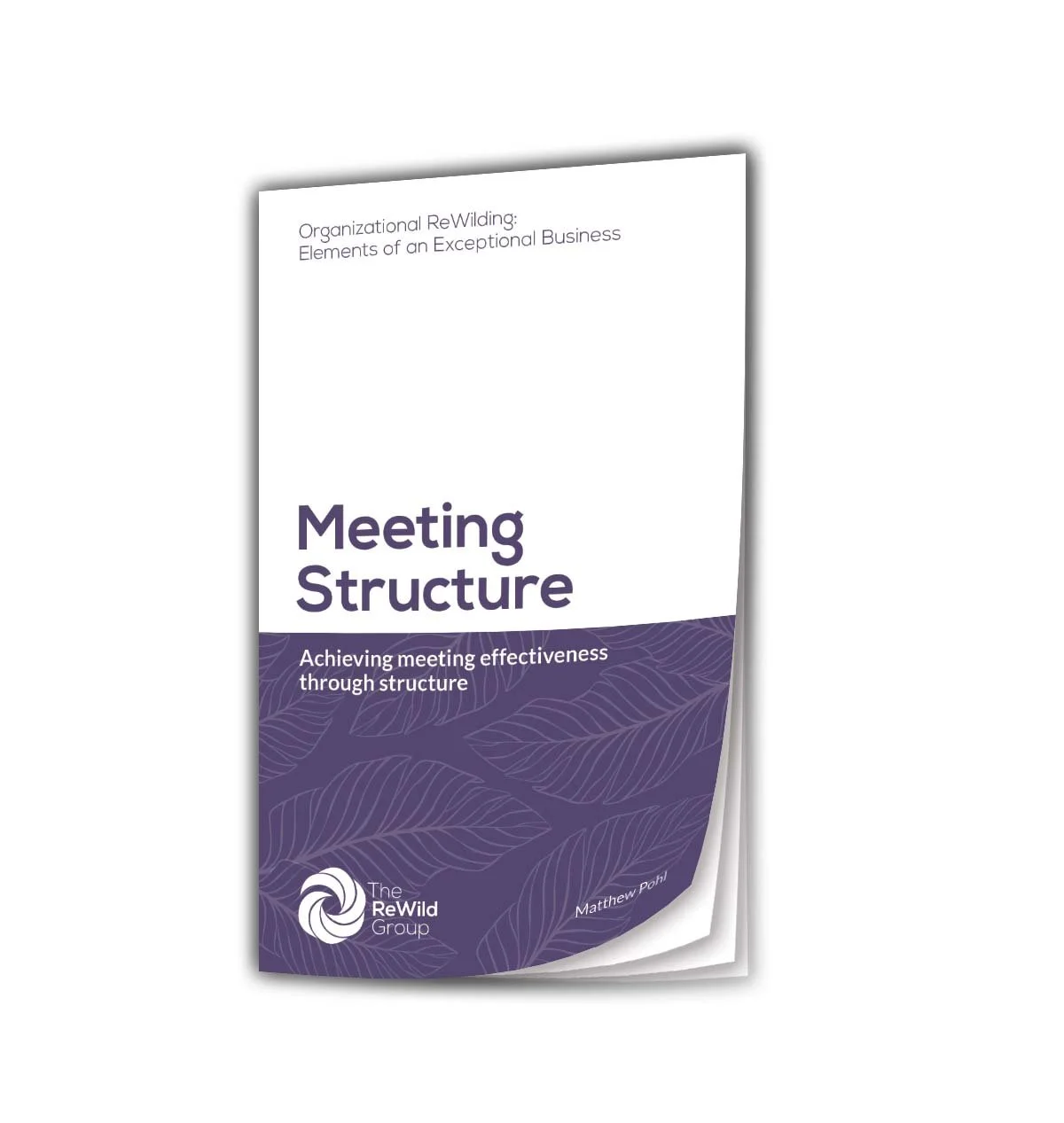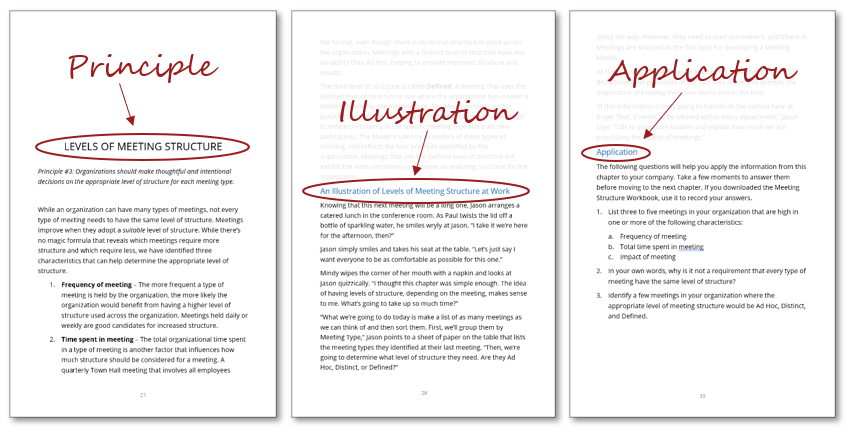The Meeting Structure Guidebook
Meeting Structure is a transformative framework that achieves meeting effectiveness through structure. It is the solution to unpopular and unproductive meetings. By introducing structure to meetings, attendees have accurate expectations and can prepare and participate according to a shared set of guidelines, resulting in less frustration and greater productivity. Practical application questions help you apply the principles to your own business.
Free Workbook Included!
The Meeting Structure Workbook is a free tool that will help you get the most out of the Meeting Structure book. A link to download the workbook can be found inside the book. The workbook includes space to take notes as well as room to record your responses to the application questions found at the end of each chapter.
Take a Look Inside
Each chapter addresses a topic related to Meeting Structure. The chapter begins with an explanation of the principle that is involved and follows with examples of what it looks like when the principle is applied to a business. At the end of each chapter there is an application section with questions that will help you apply the principle to your business.
“One more great resource from The ReWild Group to support small/medium size businesses that don’t have big business budgets but need the same business acumen infused into their company.”
An Overview of the Meeting Structure Guidebook
Meeting Structure is the solution to unpopular and unproductive meetings. By first identifying Meeting Types and then creating Meeting Models for those that require the maximum amount of structure, organizations will benefit from increased efficiency, productivity, and engagement. Each chapter explores one of the principles of Meeting Structure in-depth and then illustrates how it looks when applied to Roger That Communications, a fictional company. Below is an overview of the major concepts that inform Meeting Structure. For more details, including illustrative examples, get a copy of the book.
Meeting Structure Principles
Organizations of every size have meetings. Meetings are necessary to bring people together and create a shared perspective. The unfortunate reality, though, is that meetings are often something organizations manage very poorly or fail to manage altogether. At best, the efficacy of a meeting is left to the skills of the meeting’s organizer. The result is that, unless the person leading the meeting is highly skilled, people find meetings to be ineffective and inconsistent in achieving the needed outcomes.
Meeting Structure is how organizations ensure consistency and effectiveness of various meetings to achieve the desired outcomes. Instead of applying the same rules to every meeting—the “one-size-fits-all” approach—the first step is to organize meetings by type. Then the right meeting structure can be developed for each type.
Meeting Types Principles
The best way to discern between the meetings at your organization is to consider the purpose of each one. A meeting is only successful if it fulfills its intended purpose. If you aren’t clear on what the purpose of the meeting is, it will be impossible to make it successful—regardless of the format or the people involved.
In general, meetings serve three main purposes: to bring people together (Consistent), determine a desired course of action (Action), or to inform people about a topic or event (Informative).
The purpose of Consistent Meetings is to connect a common set of people on regular topics on a routine basis. They serve to bring people together in a familiar format where a certain topic can be given attention. Consistent Meetings are held on a regular basis, involve the same people, and are concerned with routine, ongoing work.
The purpose of the Action Meeting is to connect—for a limited time—relevant people to a specific topic that requires action. The purpose is to address a problem or concern, to plan something out of the ordinary (such as an event), or to make a decision. The people involved with Action Meetings are those who have the relevant knowledge or roles to help take the required action.
The purpose of Informative Meetings is for one person or group of people to learn from another person or group. Informative Meetings are necessary when training new hires or briefing staff on new policy or procedures.
It’s very difficult to bring a sense of cohesion and accomplishment to a meeting when expectations are not clear at the outset. That’s why it’s critical to establish the purpose of a meeting before attempting to impose structure.
Levels of Meeting Structure
Not every type of meeting needs to have the same level of structure. Meetings improve when they adopt a suitable level of structure. Three criteria to help determine the suitable level of structure for a meeting include the frequency, the amount of time involved, and the impact. The higher a meeting ranks in any one or more of these areas, the more it would benefit from structure.
The next step is to consider how much structure is appropriate. A specific meeting within a company can have one of three levels of structure: Ad Hoc, Distinct, or Defined.
Meetings with an Ad Hoc level of structure have no repeatable processes and the purpose is not formally identified.
There is no formal structure with meetings at the Distinct level of structure, but there is a shared understanding among participants of what the general purpose and format of the meeting are.
Meetings at the Defined level of structure follow Meeting Models, which create consistency and provides a clear purpose, format, and expectations.
Meeting Model Principles
Meeting Models are organization-specific templates that define a meeting’s purpose, outcomes, protocol, and positions/roles involved. They apply to meetings of the same type, even if they are held in different departments or with different teams.
A Meeting Model includes six components:
Meeting Type – The Meeting Type is selected from a pre-determined list that is developed by the organization.
Specific Meetings Where the Model is Applied – The company identifies specific use cases for the Model and lists them in this section.
Purpose – This is where the company states why they hold these particular types of meetings.
Outcomes – The expected results of the meeting are listed here.
Protocol – This section contains a guide for how the meeting should be conducted, including how formal or informal the format should be.
Positions & Roles – Any positions that should attend are listed here (avoid naming specific people) and what roles they should play (e.g., facilitator, observer, active participant, etc.).
Meeting Models by Stage
As an organization grows in complexity, so too does its need for structure to keep the complexity from turning into chaos. In general, smaller organizations are less complex than larger organizations, and necessitate fewer Meeting Models. As an organization grows, it should steadily add structure to more of its meetings.
Get the Meeting Structure Guidebook today!
Explore the entire Elements Book Series!
Organizational Structure is just one book in our series called Organizational ReWilding: 11 Elements of an Exceptional Business. Each book addresses a fundamental element of what comprises a great company.
The books are divided into four categories: Leadership, Infrastructure, Strategy, and Culture. Each one follows the same format as Organizational Structure, with chapters structured to explain a principle, illustrate what it looks like in practice using a fictional company, and closing with application questions designed to help you apply the principle to your own business. Click below to learn more.






